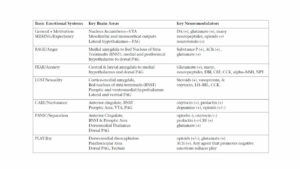
I was first introduced to the research of performance of resilience by investigators from the United States Army. They knew there were huge variations in how any recruit would respond to stress in battle and sought performance-type dogs as a model to study these variations. Unfortunately, the research was not done with the population of dogs I was working with, but it set many ideas in motion. Too often the assumptions were that low resilience was a developed character flaw, a weakness, or a human failing. In the early/mid 1900’s soldiers were labeled as “shell shocked” or “combat fatigue” and often the advice was to put them back into battle as quickly as possible . Now, it is recognized as a genuine mental health issue often refereed to as Post Traumatic Stress Disorder. It is not simply the inability to “stick it out” or “toughen up,” it is a change in our physiology that impacts our psychology.
Below are links to some articles by Jaak Panksepp, a neuroscientist who seeks to understand behavior by its earliest origins. Instead of observing complex learned behavior and making general assumptions about what might be occurring internally, he studies what happens internally and follows how neurophysiology leads to behavior. These ideas are a radical move forward in understanding behavior, specifically at the level of protein coded genetics. For the working dog this is where we should start.

Dr Panksepp’s lifetime of work distilled the beginning of behavior down to 7 basic (primitive) emotional systems that are driven by neurological substrates and specific brain structures. This improved understanding has a profound impact on our understanding of how a dog performs both behaviorally and physiologically.
https://www.psychologytoday.com/sites/default/files/attachments/109303/jcs-articlefinal.pdf
https://journals.plos.org/plosone/article?id=10.1371/journal.pone.0021236

